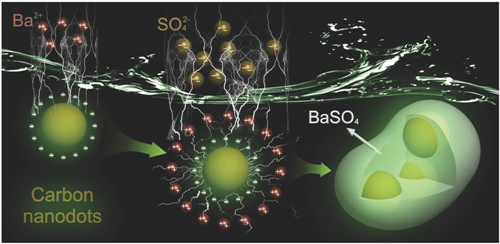

Prof. Qu Songnan and his team at the Changchun Institute of Optics, Fine Mechanics and Physics (CIOMP), Chinese Academy of Sciences have developed strong orange emissive carbon nanodots (CNDs) with a fluorescent quantum yield up to 46% – almost double the figure of previously achieved for the long-wavelength emissive CNDs. This work was recently published in the journal Advanced Materials.
CNDs have attracted research interest internationally in recent years, because they can provide carbon nanomaterials with excellent photoluminescent properties. Their distinct advantages, such as low toxicity, good luminescent properties, biocompatibility, low cost and widely available raw materials, make CNDs superior to conventional fluorescent materials.
Although strong blue and green emissive CNDs with high photoluminescent quantum yields have been developed, the development of the more efficient long-wavelength (orange and red light) emissive CNDs has been hindered by technical barriers. Prof. Qu and his team overcame these difficulties by specific chemical and engineering innovations and achieved an unparalleled photoluminescent quantum yield to 46%, surpassing previously reported yields of 24–26% for red-emissive CNDs.

Over the past 5 years, Prof. Qu’s team at CIOMP has conducted various different tests on CNDs. The team’s achievements include development of a new type of green emissive CND from citric acid and urea (Angew. Chem. Int. Ed., 2012, 51, 12215), the creation for the first time of optical pumped green lasers from CNDs (Adv. Funct.Mater., 2014, 24, 18) and the development of water-triggered luminescent nano-bombs based on supra-CNDs (Adv. Mater., 2015, 27, 1389).
In the current study, Prof. Qu’s team developed a new strategy for solvothermally synthesizing orange emissive CNDs. The band gap of CNDs can be controlled by modulating the size of conjugated sp2-domains. Prof. Qu’s team demonstrated that the organic compound dimethylformamide (known as DMF) is a good solvent for the formation of CNDs with larger sp2-domains, which are the basis of orange emissions. Using these newly developed CNDs, the team prepared efficient orange emissive CND-based phosphors and manufactured warm white light-emitting diodes. This work will further promote the development and much widen the application fields of CNDs.
For more information, please contact:
Prof. Qu Songnan
E-mail address: qusn@ciomp.ac.cn
Changchun Institute of Optics, Fine Mechanics and Physics
Source: Changchun Institute of Optics, Fine Mechanics and Physics, Chinese Academy of Sciences